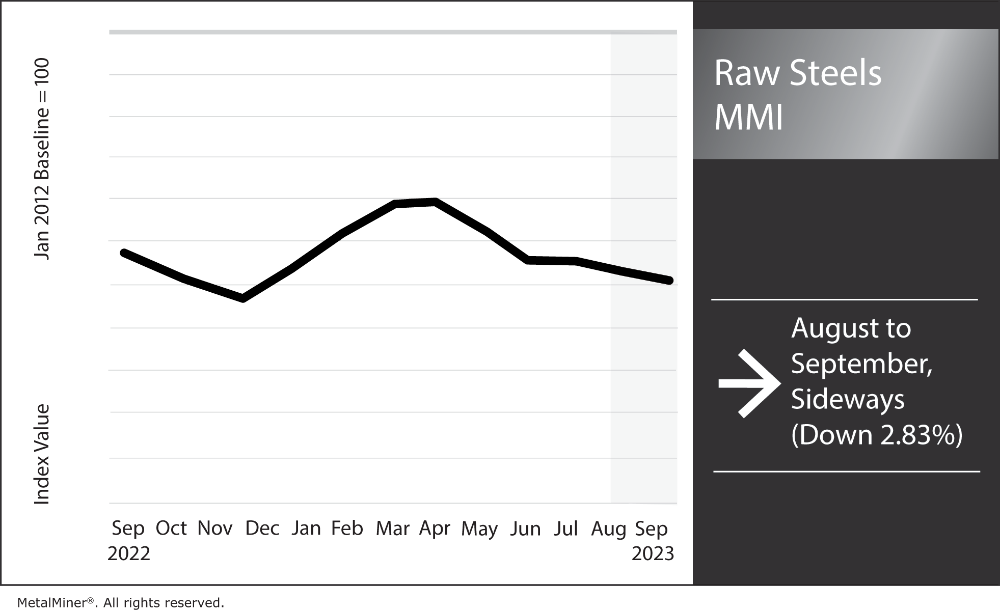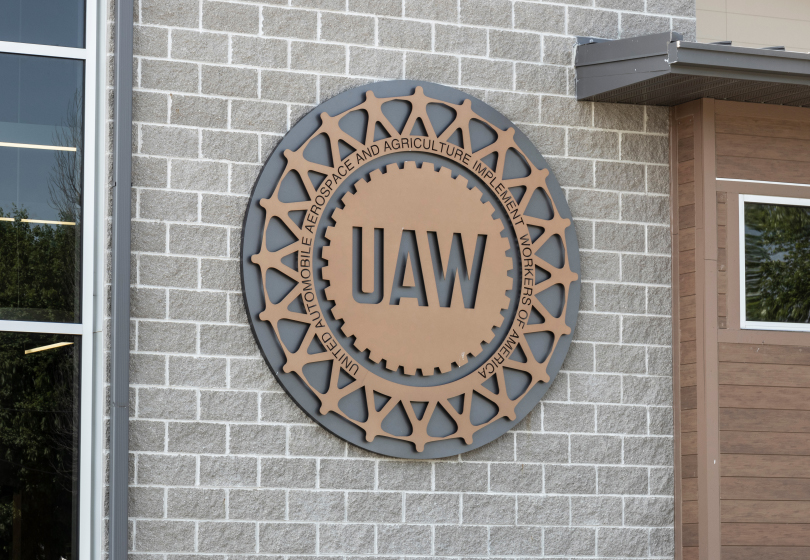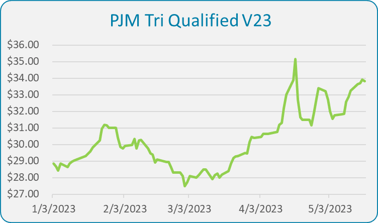The Raw Steels Monthly Metals Index (MMI) moved sideways, with a 2.83% decline from August to September as steel prices dropped almost across the board.
Indeed, flat-rolled steel prices continued their downtrends throughout August. Amid uninterrupted week-over-week declines, HRC prices saw the largest drop, falling 10.3% throughout the month. By mid-September, prices reached their lowest level since January 2023. This pushes them closer to their last major low in December 2022 in the mid-$600 per short ton range.
Don’t let soft steel markets cost you money. Sign up for MetalMiner’s free weekly newsletter and gain access to timely insights on the latest market trends, pricing and UAW strike.

UAW Strike Begins with Big Potential Loss to Auto Supply, Steel Demand
The much-anticipated UAW strike began on Sept. 14 after negotiations failed between the union and the Big Three automakers, Ford, GM, and Stellantis. On Wednesday, negotiations entered their sixth day, yet the parties failed to reach an agreement.

While the strike began with roughly 13,000 members and the potential end date remains only speculative, the UAW reportedly boasts a large enough war chest to back a 3-month walkout of its roughly 150,000 members. By conservative estimates, a strike by all members could translate to a minimum 400,000 short-ton-per-month loss in domestic flat-rolled steel demand. Accompanying this would be a more than 550,000 unit-per-month cut to vehicle supply.
U.S. Sees First Steel Blast Furnace Casualty, More Could Follow
U.S. Steel’s Granite City Works blast furnace B became the first casualty of the strike. The company will temporarily idle the 1.4 million-short-ton-per-year furnace amid the ongoing drop-off in steel demand. More cuts could follow depending on how long the strike lasts.
Data from the American Iron and Steel Institute indicates that during the week the strike began, the capacity utilization rate remained above the 75% mark at 76.2%. Meanwhile, weekly raw steel production remained steady at 1,733,000 tons. .
That said, mill lead times for flat-rolled steel already sat toward the short end of their historical range. By mid-September, mill lead times for HRC averaged around 4.5 weeks, comparable to their over 5-week average since 2019. CRC and HDG lead times both sat at seven weeks, or slightly beneath their respective historical averages of 7.3 and 7.6 weeks.
Lead times appear likely to contract further absent more substantial capacity cuts. Mills reportedly offered significant discounts on larger volumes ahead of the strike. This was to minimize the impact of a sharp loss in domestic steel demand in a seemingly already oversupplied market.
Upcoming negotiation on your steel buy? Make sure you know how mills and service centers will negotiate with you
Historical Impact of UAW Strikes on Steel Prices
The UAW strike marks the first time all three major auto companies faced concurring strikes by the union. Previously, the last UAW strike at Ford occurred in the 1970s, and the last at Chrysler occurred in 2017.
More recently, the UAW embarked on an over one-month strike at GM, which extended from September 15th through October 25th. During that time, a walkout of 48,000 workers impacted roughly 50 plants and led to considerable declines in steel prices.
HRC prices dropped nearly 16% during that time, followed by almost 10% drops in both CRC and HDG prices. Steel prices began to rebound once GM and the UAW reached an agreement, something likely to occur again once the current strike resolves. However, the current bearish dynamics within the domestic flat-rolled steel market will weigh heavily on any such price rebound. This would prove even more likely if steelmakers maintain or resume production at an over 75% capacity utilization rate.
Is the UAW going to impact your 2024 COGS? Get real-time alerts when rapid market shifts that could impact your COGS happen with MetalMiner Insights. Learn more.
How a Protracted Strike Could Impact the U.S. Steel Market
The length and scope of the ongoing UAW strike will prove determining factors on the impact on the overall steel market. It’s true that automakers reportedly ramped up production ahead of the strike to mitigate shortages. However, auto availability could become a concern for affected models should the strike last more than a few weeks. This could add support to steel prices once production resumes and those automakers work to catch up.
However, a strike longer that lasts six weeks or more could trigger a much sharper contraction in both steel prices and steel production levels, especially should the UAW expand its efforts to impact more workers and plants. If free-falling steel prices force steelmakers to cut capacity more substantially, the eventual return of auto production could translate to a sharper rebound. This would be especially true if steelmakers keep some of that capacity idled in an attempt to buoy prices up to a more advantageous range (for them).
Biggest Moves for Raw Material and Steel Prices
- LME primary three-month scrap prices moved sideways with a 1.08% increase to $373 per metric ton as of September 1.
- Meanwhile, Chinese steel billet prices fell 3.15% to $557 per metric ton.
- Chinese HRC prices saw a 3.17% decline to $562 per short ton.
- Chinese steel slab prices dropped 3.67% to $594 per metric ton.
- U.S. Midwest future prices saw the largest decline of the index, with a 6.93% drop to $725 per short ton.



